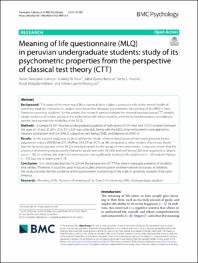| dc.contributor.author | Travezaño‑Cabrera, Aaron | es_ES |
| dc.contributor.author | Vilca, Lindsey W. | es_ES |
| dc.contributor.author | Quiroz‑Becerra, Julisa | es_ES |
| dc.contributor.author | Huerta, Samy L. | es_ES |
| dc.contributor.author | Delgado‑Vallejos, Rosali | es_ES |
| dc.contributor.author | Caycho‑Rodríguez, Tomás | es_ES |
| dc.date.accessioned | 2022-11-23T16:37:30Z | |
| dc.date.available | 2022-11-23T16:37:30Z | |
| dc.date.issued | 2022-08-24 | |
| dc.identifier.uri | https://hdl.handle.net/20.500.13053/7224 | |
| dc.description.abstract | “Background: The study of the meaning of life is essential since it plays a protective role in the mental health of
university students. However, no studies have shown the adequate psychometric functioning of the MLQ in Latin
American university students. For this reason, this research aims to evaluate the internal structure using CTT models,
obtain evidence of validity based on the relationship with other variables, perform factorial invariance according to
gender, and estimate the reliability of the MLQ.
Methods: A sample of 581 Peruvian undergraduate students of both sexes (29.5% men and 70.5% women) between
the ages of 18 and 35 (M=22.6; SD=3.3) was collected. Along with the MLQ, other instruments were applied to
measure satisfaction with life (SWLS), subjective well-being (WBI), and depression (PHQ-9).
Results: In the present study was evidenced that the model of two related factors of nine items presents better
adjustment indices (RMSEA=.075; SRMR=.059; CFI=.97; TLI=.96) compared to other models. Also, it was shown
that the factorial structure of the MLQ is strictly invariant for the group of men and women. It was also shown that the
presence of meaning was positively related to satisfaction with life (.63) and well-being (.60) and negatively to depres‑
sion (− .56). In contrast, the search for meaning was not signifcantly related to life satisfaction (− .05) and well-being
(− .07); but yes, to depression (.19).
Conclusion: It is concluded that the MLQ from the perspective of CTT has shown adequate evidence of reliability
and validity. Therefore, it could be used in future studies and evaluation and intervention processes. In addition,
the study provides the frst evidence of the psychometric functioning of the scale in university students from Latin
America“ | es_ES |
| dc.format | application/pdf | es_ES |
| dc.language.iso | eng | es_ES |
| dc.publisher | BioMed Central Ltd | es_ES |
| dc.rights | info:eu-repo/semantics/openAccess | es_ES |
| dc.rights.uri | https://creativecommons.org/licenses/by/4.0/ | es_ES |
| dc.subject | Meaning of life, Presence of meaning of life, Search for meaning of life, Undergraduate students | es_ES |
| dc.title | Meaning of life questionnaire (MLQ) in peruvian undergraduate students: study of its psychometric properties from the perspective of classical test theory (CTT) | es_ES |
| dc.type | info:eu-repo/semantics/article | es_ES |
| dc.identifier.doi | https://doi.org/10.1186/s40359-022-00913-6 | es_ES |
| dc.type.version | info:eu-repo/semantics/publishedVersion | es_ES |
| dc.publisher.country | GB | es_ES |
| dc.subject.ocde | http://purl.org/pe-repo/ocde/ford#3.03.00 | es_ES |


